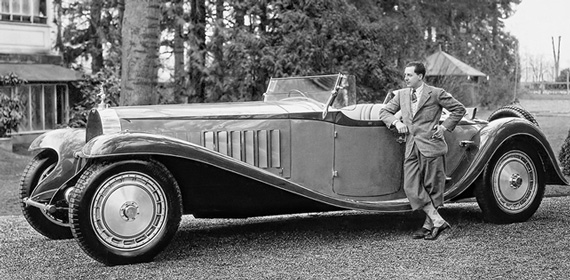
Schlumpf was fascinated by both Ettore and Jean Bugatti, as well as the cars they created. Here, a prewar picture showing Jean Bugatti with the Royale roadster he designed for Armand Esders gives a good idea of the elegance and the size this Type 41. Fin (Photo Collection Bugatti family).

Auto biographie – Pour l’amour de Fritz Broché – 10 avril 2009
de Arlette Schlumpf (Auteur), Bernard Reumaux (Collaborateur)
• Broché: 352 pages
• Editeur : La Nuée Bleue (10 avril 2009)
• Langue : Français
• ISBN-10: 2716507473
• ISBN-13: 978-2716507479
• Dimensions:24 x 2.6 x 15 cm
A summary and review by Gijsbert-Paul Berk
Part 2
The time of happiness
Soon after they started courting, Fritz began teaching Arlette to enjoy the thrills and pleasures of fast driving and to discover the ideal lines for taking – in the shortest possible time but with a minimum of risk – the many curves on the roads in the Vosges area. They often competed, each in a separate car, just for the fun of it.
Arlette also remembered that Fritz took her to the Motor Shows in Geneva and in Paris. The couple stayed in the Hotel Royal Monceau and dined at the Restaurant Castel near the Boulevard Saint Germain, where one always met interesting and famous people. In the summer they drove to St. Tropez where Arlette suddenly stood eye-to-eye with Brigitte Bardot and both of them shyly smiled at each other.
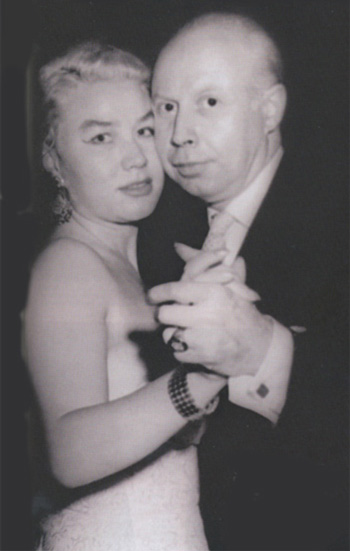 From the book photographer unknown
From the book photographer unknown
Although Fritz could afford to stay in expensive hotels and have diner in the most exclusive restaurants – which they both enjoyed – Arlette discovered that he also liked simple things. In Gérardmer Fritz converted a boathouse where he kept his sailing boat into a very small but well-equipped studio, and they regularity spent their weekends there.
There were also the trips to the famous circuits; Reims, Montlhéry, Le Mans, Monaco and Monza. Fritz knew a lot of drivers and greatly enjoyed talking with them. At these racetracks he also met and became friends with Amédée Gordini and Enzo Ferrari. Both men would help him with his collection.
A weakness for Bugatti
Fritz was determined to bring together the most interesting cars ever made. In his heart he had a special weakness for Bugattis. Not only because it had been his first car or because these cars had been conceived and produced in the Alsace, his adopted country. But he very much admired the genius of Ettore – who he had personally known before the war – and of his talented son Jean Bugatti.
Being a methodical man, he wrote to all the Bugatti owners who figured in the register of the Bugatti Book published in 1954 by Barry Eaglesfield and C.W.P. Hampton. Fritz established good contacts with a number of dealers, brokers and collectors. Among them Erwin Eckert, Henri Malartre, Serge Pozzoli, Georges Fillipinetti, Antoine Raffaëllli, André Binda, Lucien Mette, Jo Siffert and the American John Shakespeare. In February 1964 Shakespeare sold Schlumpf a collection of 30 unique Bugattis for 85,000 USD.
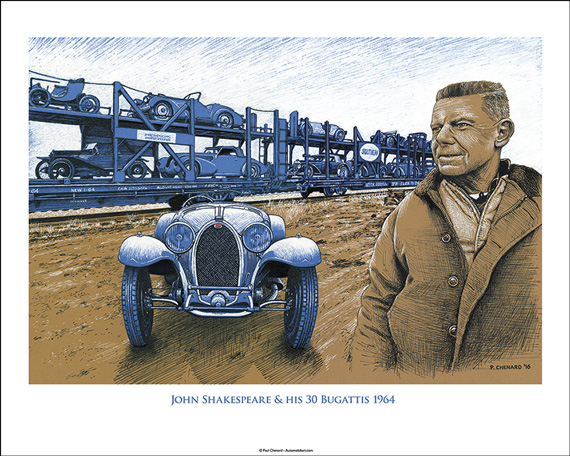
Get this poster free when you subscribe to VT. Click on photo to ready all about the 30 Bugattis of John Shakespeare.
In his book the Memoirs of a Bugatti Hunter, Antoine Raffaëllli recalls doing business with Fritz Schlumpf. “He often visited owners accompanied by the seller or middleman ‘à l’improviste’ (unannounced). After a short inspection of the car he immediately made an offer and showed the money. Of course, this did not always work. But Fritz was patient! Sometimes it took two or three years before the owner agreed”. Then, resumes Raffaëllli, “I received a check from Schumpf with the commission on the sale of a car I had completely forgotten”.
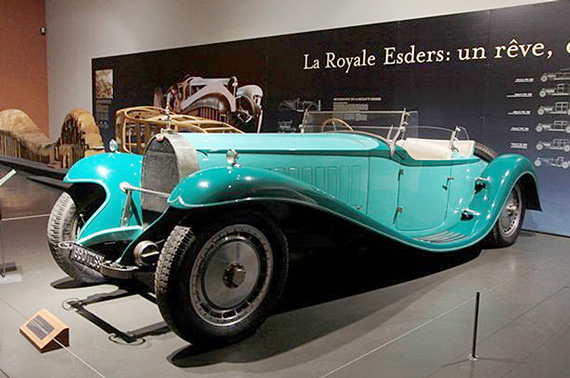
Schlumpf could not own the Esders Bugatti so he built his own. The body of the car, known as the Royale Esders, was designed by Jean Bugatti for Dr. Armand Esders, a rich clothing manufacturer. He specified that the roadster did not need to have headlights as they would spoil the lines or the car and he did not intend to use it after sunset. Eventually Esders sold the car and the new owner had it rebodied with a Coupé de Ville coachwork. This example in the Museum at Mulhouse not only looks exactly as the original Esders roadster but the construction of the roadster body is also identical. (Photo credit C. Recoura / collection Cité de l’Automoblie Muhlhouse).
A number of the Bugattis Fritz acquired were in a mediocre condition and Fritz, who already had bought a stock of old spare parts from the former Bugatti plant in Molsheim, agreed with the management to have them restore these cars. This worked to prevent the dismissal of a number of Bugatti employees.
A similar agreement was made by Fritz with his old friend Amédée Gordini. When in 1965 Gordini sold his name and his services to Renault, they were not interested in his old sports and racing cars and had no employment for the mechanics that had so long worked for him or so long. This was a great disappointment for the ‘sorcier’ and it worried him to leave his men on the dole. Fritz proposed that he would pay Gordini’s men to restore and prepare these competition machines for his exposition. A grateful Amédée bequeathed his cars for free to the new Museum.
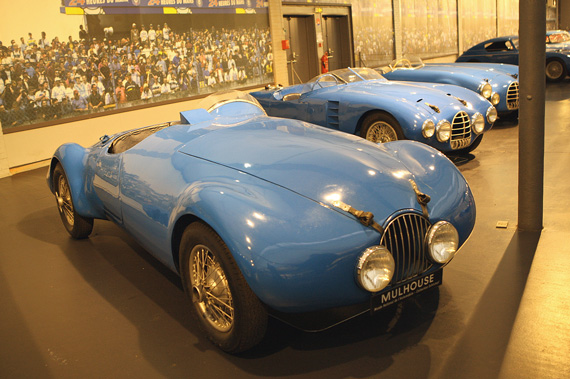
Simca Gordinis at the National Museum. Schlumpf obtained a wonderful deal from Amédée Gordini for the works cars. Photo by Jonathan Sharp.
Sometimes Fritz was offered a rare automobile for nothing. This happened when he tried to buy a prewar Voisin from an old gentleman in Villefranche on the Riviera. Fritz had seen the beautiful conserved car and told owner that he would love to have it for his museum. But, as the man did not react at all, Schlumpf resumed. “You probably don’t want to part with it … “ Then the gentleman replied. “That is not the case. I am most flattered that you want to have my Voisin for your museum. But I do not want to sell it to you….. I think that l ought to give it to you! Because I know that you will take good care of it”. The Voisin is now one of the stars in the museum.
In her autobiography Arlette states that over the period from 1961 up to 1967, the Schlumpf brothers spend a total of some 6.7 million FRF (roughly 1 million Euro), not including the cost of restoration and import duty, to purchase their more than 550 cars. Later in the book she gives a figure of 2 million Euro, all in, and observes that at least three quarters of these cars was fully restored to their original state. She also stresses that 2 million (12.7 million FRF) represented only 0.5 % of the yearly turnover of the Schlumpf group of enterprises (estimated at over 400 million).
The most extraordinary car museum
Fritz not only started collecting car like a fanatic but he also spent a lot of time and energy to prepare the museum. In 1957 the brothers had bought HKC (Heimann, Koechlin & Compagnie), an old wool mill with large production halls, in the center of Mulhouse. Fritz thought this an ideal site for the Schumpf’s new enterprise.
According to Arlette’s book, in the beginning the local authorities of Mulhouse were not very helpful with providing all the necessary permits for converting the old factory into a state- of-the-art museum and create sufficient parking space. Thus, for a while the Schlumpf brothers considered alternatives. Switzerland was one possibility. Fritz and Arlette were even invited by Prince Rainier of Monaco, who also was a car enthusiast and even had a small private collection himself. With him they discussed the possibility to establish the museum in his Princedom. Somehow the media got wind of this visit and their articles plus a letter that Fritz had written to the Prefect of the Department Haut-Rhin alerted the Mayor and municipality of Mulhouse sufficiently to improve their attitude. So in the end Fritz and Hans decided that the collection would remain in Mulhouse.
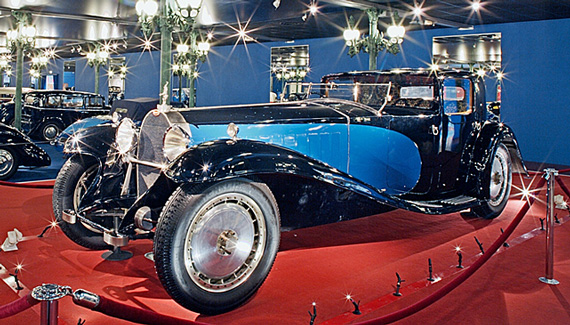
Another one of the highlights of the Schlumpf collection, still on view at the Cité de l’Automobile at Mulhouse, is the famous Bugatti Type 41 or Royale Coupé Napoleon that Fritz Schlumpf acquired from Bugatti’s daughter Ebé. Originally Bugatti intended to build Bugatti Royale chassis and sell them to royalty and wealthy industrialists. However during the Depression the market for an automobile costing over half million French Francs (US$ 30,000) was very limited. Out of the 6 Royales Bugatti produced, only 3 found a paying customer. But the engine of the Type 41 was successfully adapted for the trains Bugatti designed for the French National Railroads. (Photo credit C. Recoura / collection Cité de l’Automoblie Muhlhouse)
It must be admitted that Mulhouse was not the most obvious choice to establish a prestigious museum. But Arlette explains in her book that Fritz and Hans had their reasons. They wanted the museum to become a monument for their beloved mother Jeanne who was born in Mulhouse and until she passed away in 1957, had been so happy there. Also, both of them had grown up in Mulhouse. Furthermore they believed that such a venue would stimulate tourism and thus create employment, not only for the hotel and restaurant trade, but for their own workers as well. This was quite important to them, as they also were fully aware that the future of the Alsatian textile industry did not look too bright.
Fritz’s ambition was to establish the most prestigious industrial museum in France. What he had in mind was not just an exhibition of classic cars, but the ‘Louvre of the Automobile.’ His ideal was a multifunctional center with a cultural and educational mission of emphasizing the role of the automobile in the industrial evolution of the world, and its influence on society.
Arlette recounts that in 1964, she and Fritz purchased an enormous mechanical Mortier organ made in 1910. For many years it had stood in a ‘maison de rendez-vous’ (exclusive brothel) and was completely restored by a specialist in Belgium. It had thirty-two boxes of music that contained national hymns but also popular tunes such as ‘Mamy Blue’, a favorite of Fritz’s, and ‘Vous permettez Monsieur’ from the repertoire of the singer Adamo. The latter was played when in 1978 François Mitterrand visited the museum. The French president obviously liked it and it brought a smile on his face. Fritz also acquired a 1936 Douglas DC 3, which he wanted to put on the roof of the building.
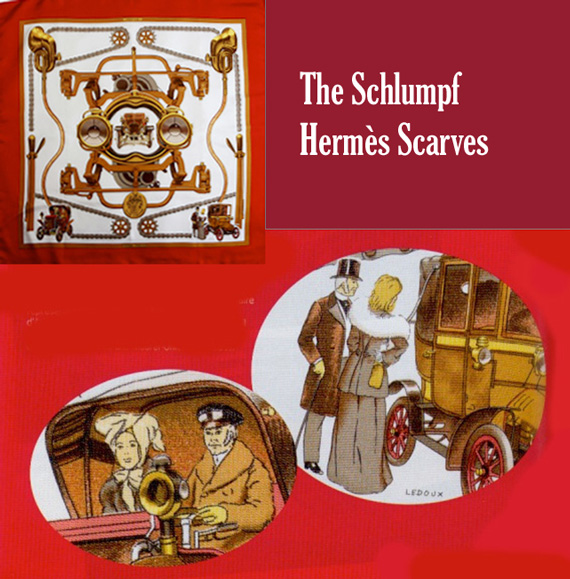
Fritz interfered personally with the design of the Hermès scarves. He asked Philippe Ledoux, its designer to include a portrait of him – recognizable by his prominent sideboards – to be seated behind the wheel of one of the two cars and standing alongside the other. In each of the two drawings, he was accompanied by a different female figure. One represents Arlette, blonde hair flowing and hand on hip. The other is that of a young girl – Arlette’s daughter. Martine – wearing a scarf that is folded as a traditional Alsace coif. A total of 1475 of these Hermès scarfs, in eleven different color combinations, were exclusively produced for the Schlumpf Museum. These scarfs are still available form http://www.schlumpf-collection.com/ at a price of €500.
In 1975, the Schlumpf brothers registered the Societé Annonyme Musée Schlumpf, in order to legally separate the museum from the industrial activities of the group. Fritz intended the museum to be open for its first paying visitors in the week before Easter 1976. He invited over 600 journalist and expected some 1400 friends, business relations and authorities to attend the grand opening. Fritz persuaded his friend Robert Dumas, head of the design team of the emblematic Maison Hermès, to produce an exclusive scarf for the occasion. He had also stocked 3500 bottles of Schlumpf Champagne for his quests.
However, the financial problems of the Schlumpf wool mills forced him to postpone his plans. What then followed is history and has been told many times before.
Next week Part 3, The crash...
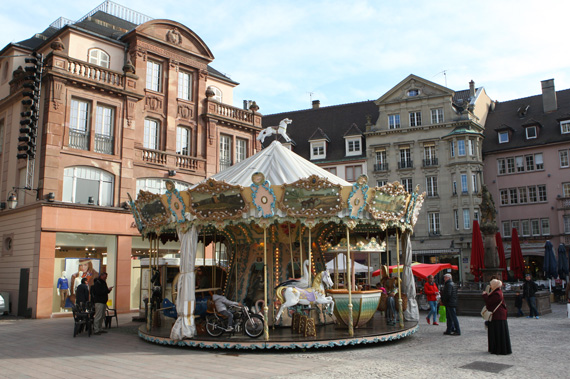
A book you must read! The looting of the Schlumpf’s house by the trade organisations, the subsequent return to Swiss as advised by French police which on the following morning was announced by the press as a flee, as if they were runaways and I could go on and on.
Suffice to say that this was organized theft by a local communist government, with tacit approval from French socialist power in place in the early 80’s.
The first part of the book is very explicit about how much the Schlumpf’s were close to their mother and their employees, they had a high sense of social welfare and were among the first to have set up a hospital dedicated to their workforce as well as holidays on the French seaside.
Made me truly ashamed of being French this book, I must tell you it is truly shocking.
As of late the museum is now called “La cité de l’Automobile”, were did the Schlumpf name ever go?
Cars have all been declared national property and cannot leave French borders.
Fritz should have listened to Rainer, the museum would have been on safe ground in Monte-Carlo.
Essential reading for any car nut!
Thomas
Fr….ance
Wait until you read Part 3 next week!
Ed.
Hi Pete,
Can’t wait to!